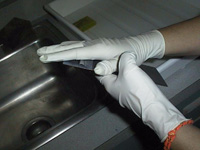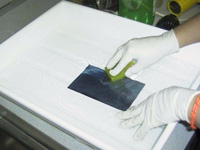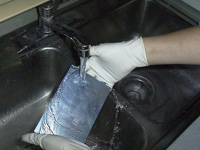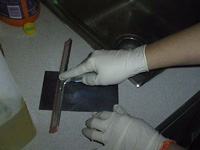Contone
Intaglio-Type
For working with photographic continuous tone imagery and
duotone plates.
Materials:
- Plate laminated with ImagOn
Overview:
The difference between a continuous tone and a halftone lies in the
perceptible dot structure within the positive film image. In working
with a continuous tone photograph it is first necessary to describe a
couple of simple ways in which a continuous tone film positive can be
made. Although continuous tone implies the lack of a visible dot
structure I have developed a technique of making a film positive that
lies between a halftone and a continuous tone that I will call a
soft-halftone that can also be included in the Contone
Intaglio-Type.
|
|
Recommended procedure:
Prepare Plate
Adhere ImagOn to plate
|
|
.
|
The Conventional Halftone
- The recommended film for making
both halftones and continuous tone film positives is the Fuji Grandex
lith film. When making a halftone film image a halftone screen is
necessary. The halftone screen can be either a commercially available
one or in lieu of this a sheet of non-glare glass or non-glare
Plexiglas can be used. When a photographic negative is projected from
a photographic enlarger through the halftone screen on to the
Grandex lith film the resulting positive is recorded onto the
Grandex film as a series of dots. When the non-glare glass and
Plexiglas is used this dot structure looks similar to the random dot
structure of an aquatint. The problem with attaining superlative
results with a finished photo intaglio print is directly related to
how well this original halftone is made. Unfortunately understanding
the creative dynamics of making high quality halftones for intaglio
printmaking takes considerable experience and working knowledge. For
those printmaker who lack specific experience in making high quality
halftones I have developed alternative solutions to the problem of
achieving a photo intaglio print. It should be stated that there is
little that can rival the image quality achieved from a high quality
halftone so these following techniques are meant not as a substitute
but rather a way of developing knowledge and working experience with
these photo intaglio techniques.
|
|
|
Material requirements
- Fuji's Grandex Lith film .
- Either Dektol or Multigrade paper
developer.
- Film Fixer
- Black and white darkroom with red
safe lights
- Black and white negatives such as
produced from Kodak's T-Max or Ilford's XP2 camera film.
Overview
- Space only allows for a brief
description of this technique. There are two types of developer that
can be used with the Grandex lith film the first is the actual lith
film developer that was designed by Fuji to develop this film and
secondly certain "soft" developers can also be used. When
lith film developer is used to process the Grandex film the film's
emulsion is rendered opaque and if a halftone screen is not used then
all intermediate gray tones will have dropped out. Known in the
photographic industry as a tone drop-out. When a "soft"
developer is used with this same Grandex lith film the results
simulate what is normally achieved with the tonal variation present in
your T-Max camera negative. In other words a soft developer allows you
to have a positive reading images with all of the tonal values from
black to white without the obvious dot structure present in a halftone
image.
|
|
|
Making The Continuous Tone Positive
- Basically a black and white negative is placed into a photographic
enlarger and projected on to the Fuji Grandex lith film. The film is
then developed in either Dektol paper developer diluted 1 part
developer to 6 parts water. This dilution can vary for different
results. Ilford's multigrade developer diluted 1-9 with water can also
be used. The film is subsequently fixed until it becomes transparent
in the fixer and washed.
- A "soft" halftone can also be made which represents
a halfway point between a normal halftone and a continuous tone. To
make a soft halftone a halftone screen is placed on top of the Grandex
lith film during the exposure from the negative as outlined directly
above. The continuous tone and soft halftone should have a tonal range
that is representative of the tonal range that would be present if a
black and white photographic image was made.
|
|
|
The Contone Intaglio-Type plate
Depending on how opaque the black areas of the continuous tone or soft
halftone are one or two layers of ImagOn film can be applied in a number
of different configurations as follows;
- One layer of ImagOn exposed first to the aquatint screen and then to
the continuous tone positive.
- Two layers of ImagOn film applied to the plate which are subsequently
exposed to the aquatint screen and then to the continuous tone
positive.
- One layer of ImagOn film is applied to the plate and exposed to the
aquatint screen followed by another layer of ImagOn to which the
continuous tone is exposed.
After exposure to the final image the plate is processes in the same
manner as All of the Intaglio-type techniques.
It is extremely important to finely tune your exposure times for the
Contone Intaglio-Type technique as an exposure factor of plus or minus 1
second can make an appreciable difference to the tonal range of the
finished intaglio print. The tonal range in the Contone Intaglio-Type is
achieved by how much quantity of UV light is allowed to penetrate the
surface of the ImagOn film. So that during the final development of the
plate the areas of the plate that will carry the softer tones within the
image are the most exposed areas within the plate. The longer the plate
is exposed the lighter will the be the resulting area in the
finished print. The continuous tone positive selectively filters the UV
light passing through in to the ImagOn emulsion. It is the density
variation within the continuous tone positive that cause this selective
exposure of the ImagOn emulsion that then creates the illusion of tonal
variety in the finished print.
This technique tends to cause a reduction in the potential tonal
scale that would normally be possible with a halftone. This deficiency
of tonal range can be compensated for my using the Layered
Intaglio-Type plate making method and combining this plate making
technique with a duo-tone printing technique. Unfortunately when working
with a duo-tone printing technique two continuous tone positives
and two plates must be made. The two continuous tone positives are made
from the same negative but each represents a different selection of the
tonal scale. One lith film positive would be representative of the
lighter tones hence it is exposed for less time during the photographic
exposure stage. The other continuous tone positive is exposed for more
time, during the photographic exposure stage, to reveal a positive
representative of the darker tonal scale. This latter positive is used
with the Layered Intaglio-Type in conjunction with a pre-aquatinted
lower layer of ImagOn film. The other highlight plate only needs
to have one layer of the ImagOn film that is pre-exposed to the aquatint
screen after which the highlight positive is exposed to it.
|

Rubber gloves RECOMMENDED for
the development procedure. Repeated use of developing solution can dry out
the skin and cause a dermatitis reaction on the hands.

Eye protection advised.
The developer is an alkaline solution. Do not
splash the developing solution into eyes.

Dry without heat
|
Develop
 . .   . . 
|
Print
Clean Up of Printing Plate and Inking
Station
- Vegetable oil (canola) and a rag.
- Degrease with magnesium carbonate.
- Put up all paper, plates, inks on
personal or appropriate studio shelf and drawers.
Keep studio orderly

 .
. 
 .
. 